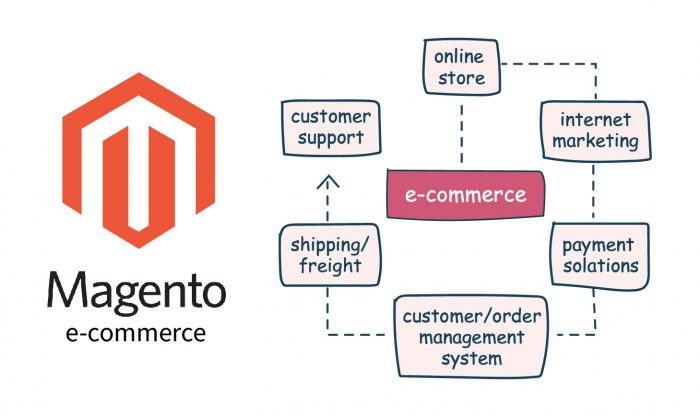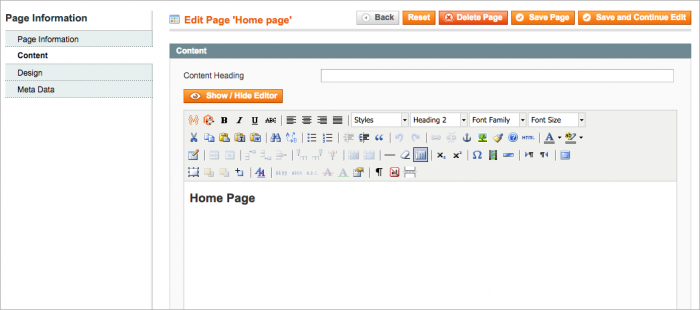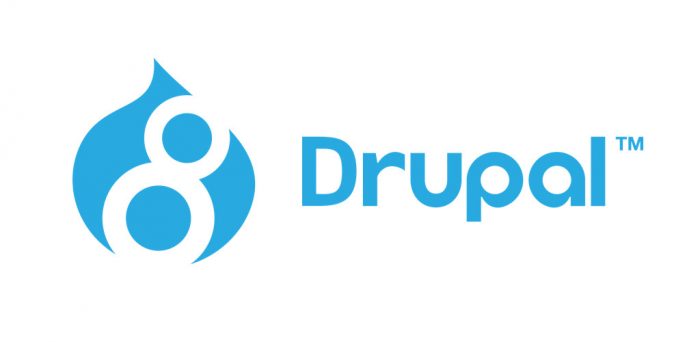Magento is an eCommerce giant supported by many developers, but that doesn’t mean every merchant has a developing team for themselves to develop and integrate their website. And therefore, depending on the resources you have, you can consider using the built-in Magento CMS, or incorporate a separate CMS for content management.
The CMS (Content Management System) is the tool to create content on the website even without much coding experience. Given that both B2B and B2C companies are craving content marketing to reach out to their customers, they need a technical tool that can transform creative marketing ideas into blogs, banners, content blocks, and content format of their choice.
While using the built-in Magento CMS doesn’t need many configurations right out of the box, using a separate and functional focus CMS would require developers, or contact a Magento development service to integrate the Content Management System for your site.
BEGIN CMS integration NOW with Magento 2 Web Development Service for a STUNNING website!

Clear The Misunderstanding: Is Magento a CMS system?
Table of Contents
First, let’s get the misunderstanding about Magento and CMS out of the way. Many retailers refer to Magento as a CMS system, but a platform primarily focus on CMS will create and publish digital content (such as text, images, audio, etc.).
In the customer journey, CMS lie in the product descriptions, pictures, and banners widget on the page, press release page, or any piece of content meant to enhance the website interface and provide information about the products that your business is selling.
While Magento does allow content employment, it’s not the main function of the platform. Both Community and Magento Commerce versions have been designed and optimized for ecommerce needs, and have signature features including product inventory management, processing orders and connecting to payment gateways, etc.

So there you have it: Magento is an ecommerce platform, and while Magento CMS does play the role of producing content and display designs on websites, it’s only a facet of the comprehensive picture for the platform use cases.
Default Magento’s CMS Pros and Cons
We can first rely on statistics to prove that Magento CMS is worth the analysis. According to W2Tech, half of the websites are using a CMS system, and Magento accounts for 1.2% of the CMS market share.
Also, Magento merchants who don’t have many resources want to rely on out-of-the-box options, and Magento CMS offers just that.
The Magento CMS changed significantly before and after Magento Commerce 2.3, and that’s why I think there should be a “before-after” comparison. This will draw a big picture of the features that merchants get when investing in different Magento platforms.
Before Magento Commerce 2.3
Although having a long history of developing and improving to this powerful ecommerce platform, the CMS for Magento before Magento Commerce 2.3 was still quite functionally limited.
- Magento default CMS limit the content formats and templates to basic ecommerce pages (like catalogs and product descriptions) or default pages (Home, About Us, Customer Service, Privacy Policy, 404 Not Found, Enable Cookies, and Service Unavailable). This limited the customization and templates for the content pages on Magento websites.

- The WYSIWYG editor has a similar interface to Microsoft Word, making it easy to create informative and simple web pages. But if you want style and seamless design, then you would have to rely on HTML and CSS, and many Magento admins struggle to transfer their ideas due to this dependency on technical skills.

All in all, the Magento default CMS prior to Magento Commerce 2.3 delivers all the basics but fails to have a convenient page editor that has diverse content types.
After Magento Commerce 2.3
In 2016, Magento acquired Bluefoot technology and resolved the problems addressed by merchants regarding Magento CMS.
The successor is a drag-and-drop page builder instead of the old WYSIWYG editor, which you don’t need much programming to operate – pick a layout, and then build the page by drag and drop content blocks, type the content in and decide which block goes where (like headings, promotion banners, images, etc).
Benefits:
Magento page builder was easy to manage, transferring the creative ideas of owners to the site without them having to learn developing skills, but a little programming can still push the website’s design further.

GET READY to know more about Magento Page Builder and BREAK LIMITS of your Magento website!
Limitation:
Everything good comes with a price. While Magento Commerce provides users with many conveniences, Magento Commerce license costs start at $24K and grow as the company’s gross revenue grows.
Small businesses and startups often find the costs excessive and satisfied with using Magento Open Source instead. If you’re wondering about the expenses needed to build a Magento website, you can look at our Magento services for a personalized consultation or get a read on:
CLICK to GET ALL you need to know about Magento site costs under your fingertips!
Solution in Managing Content – Custom CMS Platforms Integration
As the price for Magento Commerce is relatively high for minor firms, people seek for a solution to compromising functionality and expenses. The other solution aside from using Magento CMS, for Magento Content Management, is Magento CMS integration.
Advantages: Marrying a custom CMS platform and Magento has a lot of merits:
- You can take advantage of both platforms, turn your website into a content-friendly as well as a secure and ecommerce feature robust online store.
- Your store is well supported and continuously improves in all aspects, from marketing content to ecommerce abilities.
- A better UX created from content focus CMS can boost your site’s SEO rank in the Google Search Results.
- You will gain more templates, content layouts, customized pages, which breach Magento’s limitations and lead your site to be both informative and design appealing.
Disadvantages:
- It would help if you had assistance from an experienced developer team or contact a trusted web development service provider to integrate the custom cms system for you. If freelancers or inexperienced agencies did the integration, you are at risk of severe security issues.
There are several commonly used custom cms, which you should consider: WordPress, Drupal, and Joomla.

WordPress

WordPress is a user friendly and popular content management platform. It was used by 63.6% of the CMS websites, and constantly be the first choice for bloggers and website owners in 2019 and beyond. But as we consider them as a Magento integration CMS, we have to weigh the pros and cons carefully before making decisions:
Pros:
- WordPress is easy to use. Pretty much anyone can pick up how to use it in a short amount of time. Despite being simple for website owners to navigate and update content, it’s a robust content management system due to its origin in blogging.
- If you’re using WordPress, then you should have realized that there are mostly 54,000 free and paid plugins at your disposal. The plugins help add function, customized, and enhance the website interface. There are also a large number of SEO plugins that help optimize content, meta tags, keyword focus, and other SEO metrics.
- WordPress also means an extensive collection of themes. And with the internet these days being mostly through smartphones, it’s essential for a consistent, responsive mobile theme across all devices.
- WordPress is open-source code and saves time since you can use the existing code instead of building from scratch.

Cons:
- Being an open-source Magento cms integration platform, WordPress codes are also available to other users. This means the security is not high, and your website could be hacked.
- WordPress needs maintenance and upgrade along with the platform; otherwise, the website can be slow. Considering you also have to upgrade your Magento site, it would be double the work, the developer resources, and possibly the costs.
Drupal

Drupal is often mentioned alongside WordPress and Joomla, and as the other CMS systems, it is also packed with features suitable for small businesses, startups, and personal websites.
Similar to WordPress and Joomla, you can either have your team integrate the platform, or hire Magento development service to perform the integration for you.
Magento cms integration with Drupal will have certain advantages and shortcomings, which you need to weigh before seeing if this is suitable for your site.

Pros:
- Drupal has what it takes to create a complex and broad-scale website. The platform is entirely free to compete with WordPress and Joomla, and it also has open-source codes, which means users can rebuild it according to specific needs.
- Drupal is flexible with the content formats it can produce: information pages, forums, polls, news, blogs, etc.
- Drupal is supported by a large community of specialists and professional programmers who provide plugins, bug fixes, and support documentation.
- One of the strong points of Drupal is its security. Compared with WordPress and Joomla, it’s less prone to hacking. It also posts security reports on the Drupal official website and quickly has patches for any security issues.
Cons:
- Drupal is more complex to use than other CMS and requires necessary coding skills and a deep understanding of Drupal functions.
- Due to its complex nature, Drupal also needs more effort and time on your parts.
- Drupal has had some performance issues with module compatibility, speed optimization, etc.
Joomla

Joomla is the CMS used by some giants in the ecommerce industry like MTV, Ikea, eBay, etc. It’s gaining popularity because it’s considered more secure than WordPress and can be an alternative Magento cms integration to WordPress if the others face too many intrusions.
Pros:
- Joomla is easy to install and use, friendly to beginners as the vast majority of Joomla users don’t have to touch any code at all.
- Joomla is also an open-source platform, which means you can modify and distribute codes with no license fee to worry about.
- Joomla supports a diversity of contents, and is flexible with the content formats that users choose.
- Joomla also has a large community that you can get advice, tips, tricks, etc.
Cons:
- Joomla has a small module marketplace, and therefore, it isn’t easy to find plugins with sophistication.
- Joomla’s user interface is more complicated than other CMS as it has more functions and configurations.
Concluding Points
Content management is a major concern for Magento merchants. We have listed above the options for a store owner to consider in Magento CMS integration, and if you still have any questions, feel free to reach out to us at any time.
With over seven years of Magento service experience, BSSCommerce promises the best quality for every project we do. No matter where you’re in your journey, our senior Magento developers & Magento consulting specialists will help you develop your Magento website. We also got you covered with any other service, from the speed-up consulting package, maintenance to migration, data entry, etc.
>> CHECK OUT our full Magento Website Development services right now!
CONTACT NOW to explore our services and boost your business to the next height!
